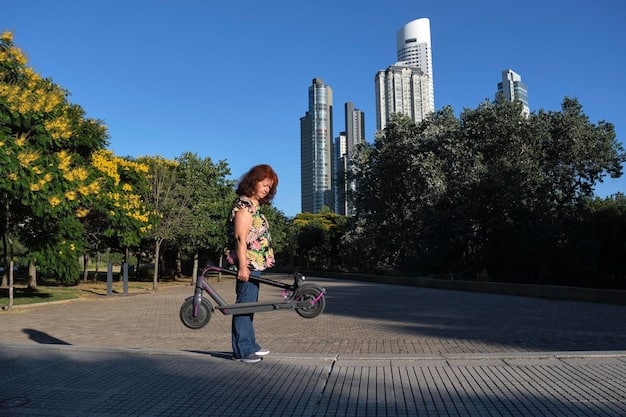Green Your Commute: Eco-Friendly Hacks to Save $500+ Annually

Green Your Commute: Save $500 Annually with These Eco-Friendly Transportation Hacks explores cost-effective and environmentally responsible alternatives to traditional commuting, offering actionable strategies to reduce your carbon footprint and save significant money each year.
Transform your daily travel into an eco-friendly adventure and discover how to Green Your Commute: Save $500 Annually with These Eco-Friendly Transportation Hacks, reducing your carbon footprint while boosting your bank account.
Why Green Commuting Matters
Choosing green commuting options isn’t just a trend; it’s a crucial step towards a sustainable future. By opting for eco-friendly transportation, you can significantly reduce your environmental impact and contribute to cleaner, healthier communities.
Beyond the environmental benefits, green commuting can also improve your physical and mental well-being. Incorporating active transportation into your daily routine can boost your fitness levels and reduce stress, while saving money on fuel and parking.
Reducing Your Carbon Footprint
Transportation is a major contributor to greenhouse gas emissions. By switching to greener commuting methods, you directly reduce your carbon footprint, helping to combat climate change.
Cost Savings
The financial perks of green commuting are substantial. From saving on gas and car maintenance to reducing parking fees, the savings can quickly add up.
- Lower fuel costs
- Reduced car maintenance
- Elimination of parking fees
- Potential tax incentives
Embracing green commuting is a win-win situation for both your wallet and the environment. It’s a simple yet powerful way to make a positive impact and contribute to a more sustainable future.

Top Eco-Friendly Transportation Options
There are numerous ways to green your commute, each offering unique benefits and catering to different lifestyles. Exploring these options can help you find the perfect fit for your needs and preferences.
From cycling and walking to public transportation and electric vehicles, the possibilities are endless. Consider your daily distance, budget, and personal preferences to determine the best approach for you.
Cycling
Cycling is a fantastic way to combine exercise with your daily commute. It’s an affordable, emission-free option that improves your fitness and reduces traffic congestion.
Public Transportation
Buses, trains, and trams offer a convenient and eco-friendly alternative to driving alone. Public transportation reduces the number of vehicles on the road, lowering emissions and easing traffic.
Carpooling and Ridesharing
Sharing a ride with colleagues or neighbors is a simple way to cut emissions and save money on fuel and parking. Carpooling reduces the number of cars on the road and fosters a sense of community.
- Reduced travel costs
- Lower emissions per person
- Opportunity for social interaction
- Access to HOV lanes
Choosing the right green commuting option depends on your individual circumstances. Evaluate your options and consider combining different methods to create a sustainable and enjoyable commute.
Calculating Your Potential Savings
Visualizing the financial benefits of green commuting can be a powerful motivator. By calculating your potential savings, you can see exactly how much money you could be saving each year.
Consider factors like fuel costs, parking fees, and vehicle maintenance. Compare these expenses to the costs of alternative commuting methods like cycling or public transportation.
Fuel Costs
Calculate your current fuel expenses based on your vehicle’s fuel efficiency and the price of gas. Determine how much you could save by switching to a more fuel-efficient option or eliminating fuel costs altogether.
Parking Fees
Parking fees can be a significant expense, especially in urban areas. Explore alternatives like cycling or public transportation to avoid these costs.
Vehicle Maintenance
Reducing your reliance on your car can significantly lower your vehicle maintenance expenses. From oil changes to tire replacements, the savings can add up quickly.
By taking the time to calculate your potential savings, you can gain a clearer understanding of the financial benefits of green commuting. This can help you stay motivated and committed to your sustainable transportation goals.

Tips for a Successful Green Commute
Transitioning to a green commute requires planning and preparation. By following these tips, you can ensure a smooth and successful transition.
From planning your route to investing in the right gear, these strategies can help you overcome common commuting challenges and make the most of your eco-friendly travel.
Plan Your Route
Research the best routes for cycling, walking, or public transportation. Look for bike lanes, pedestrian-friendly streets, and efficient public transport connections.
Invest in the Right Gear
Equip yourself with the necessary gear for your chosen mode of transportation. This might include a comfortable bike, walking shoes, or a monthly public transportation pass.
Stay Safe
Prioritize safety by wearing appropriate protective gear, such as a helmet and reflective clothing. Follow traffic laws and be aware of your surroundings.
- Wear a helmet when cycling.
- Use reflective gear at night.
- Stay hydrated, especially during hot weather.
- Be aware of traffic and pedestrians.
With careful planning and preparation, you can overcome potential challenges and enjoy a safe, sustainable, and rewarding green commute. Embracing these tips will help you stay committed to your eco-friendly transportation goals.
Overcoming Common Commuting Challenges
Every commute presents unique challenges, but with a little creativity and problem-solving, you can overcome these obstacles and maintain your commitment to green commuting.
From inclement weather to time constraints, these strategies can help you navigate common commuting hurdles and stay on track with your sustainable transportation goals.
Inclement Weather
Prepare for inclement weather by investing in waterproof gear and planning alternative routes. Consider using public transportation on particularly challenging days.
Time Constraints
Adjust your schedule to accommodate potential delays or longer travel times. Consider listening to podcasts or audiobooks during your commute to make the most of your time.
Distance
If you live far from your workplace, consider combining different modes of transportation. For example, you could cycle to a nearby train station and then take the train to work.
By anticipating and addressing potential challenges, you can ensure a smooth and consistent green commute. With a proactive approach, you can maintain your sustainable transportation habits, even when faced with obstacles.
Long-Term Benefits of Eco-Friendly Transportation
The benefits of green commuting extend far beyond individual cost savings and environmental impact. Embracing eco-friendly transportation can lead to long-term positive changes for individuals, communities, and the planet.
From improved health and well-being to enhanced community connections and a more sustainable future, the rewards of green commuting are numerous and far-reaching.
Improved Health and Well-being
Incorporating active transportation into your daily routine can improve your physical and mental health. Regular exercise can reduce your risk of chronic diseases and boost your mood.
Enhanced Community Connections
Green commuting can foster a sense of community by encouraging interaction with neighbors and fellow commuters. Carpooling, cycling groups, and public transportation can create opportunities for social connection.
A Sustainable Future
By reducing your carbon footprint and promoting the adoption of sustainable transportation practices, you are contributing to a more sustainable future for generations to come.
The long-term benefits of green commuting are substantial and contribute to a healthier, more connected, and sustainable world. By embracing eco-friendly transportation, you are investing in a brighter future for yourself and for generations to come.